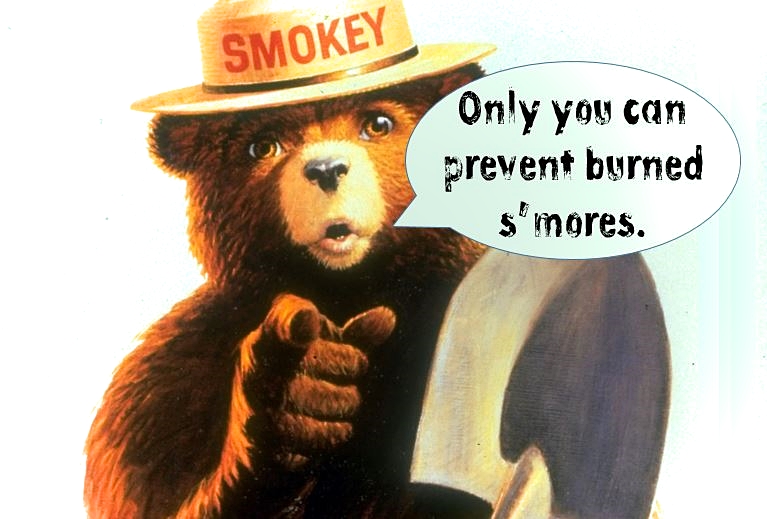The lack of management that has caused the death and destruction of massive swaths of forestland is not entirely the Forest Service’s fault, of course. It is true that an anti-forestry culture pervades an agency once filled with professionally trained foresters, but now dominated by wildlife biologists and ecologists.
Greg Walcher
Roasting marshmallows, not forests
If you have fond memories of roasting marshmallows around the campfire, and making s’mores with the kids, you may be surprised to learn that you’ve been doing it wrong all this time. Fortunately, the U.S. Forest Service has finally published guidelines on the correct method for roasting marshmallows and making s’mores.
The government’s advice begins with choosing a stick at least 30 inches long, so nobody gets burned. That seems obvious enough, but the government can never resist an opportunity to change our behavior. So this seemingly innocuous item ends with eating less sugar, so we should substitute fruit for the chocolate, and angel food cake for the graham crackers – a fruit and white cake s’more. Marie Antoinette would be so proud. The kids might not be happy, but they’ll be healthier, thanks to our government.
Some readers of the Forest Service guide openly wonder if there remains any aspect of life that we are capable of living without the government telling us how. But we ought to be asking an entirely different question: doesn’t the U.S. Forest Service have anything better to worry about? It is unknown how many marshmallows have burned in the last 15 years, but during that time over 100 million acres of forests have burned — and another 8.5 million acres so far this year.
The lack of management that has caused the death and destruction of massive swaths of forestland is not entirely the Forest Service’s fault, of course. It is true that an anti-forestry culture pervades an agency once filled with professionally trained foresters, but now dominated by wildlife biologists and ecologists. They spend far more time cranking out paperwork than actively managing anything. And today’s forest politics are driven largely by outside interest groups that oppose any thinning of the overgrown forests, or any other cutting of any trees, anywhere, anytime.
Still, much of the fault for the agency’s failure to manage lies with Congress. Despite years of “oversight” hearings on this crisis, the funding process and policy direction remain dysfunctional. Imagine if we expected the Federal Emergency Management Agency (FEMA) to continue all its normal annual activities, while also absorbing within its existing budget the costs of unforeseeable events like the almost-simultaneous hurricanes in Houston, Florida, and Puerto Rico. That would be irrational, so Congress passes emergency supplemental funding bills to handle such unforeseen disasters. After Hurricane Katrina hit New Orleans in 2005, Congress passed $100 billion of emergency funding. Not so with the unforeseen disaster of catastrophic forest fires.
It is long past time for Congress to put an end to “fire borrowing,” that is, the expectation that the Forest Service pay for fire-fighting costs out of its existing budget. The current line item in that budget for firefighting actually expects officials to guess: how many fires of what size might happen next year. That’s absurd, and it doesn’t work. Thus, fire-suppression and firefighting budgets are always exceeded, and the money “borrowed” from other accounts, including those which pay for forest health restoration projects, and thinning the forests to a more natural level.
Now, more than 65 groups have written Congressional leaders, using stronger terms than ever before, seeking permanent reforms in forest management and fire funding. The signers — including Club 20 — are more diverse than ever, with commodity associations, the Farm Bureau, local governments, sporting, conservation, and business groups. They seek elimination of “fire borrowing” and separate financing for catastrophic fire costs, as with all other national emergencies.
However, the letter also wisely acknowledges that fixing the budget problem “alone will not address the underlying forest health crisis that is literally fueling these severe fires.” Solutions to the forest health crisis must also include meaningful policy reforms to increase active management. The Forest Service now estimates that perhaps 80 million acres are overgrown, dead, dying, or at risk of catastrophic fires, insects, and disease. There are over six billion dead and dying trees in our national forests, including 834 million dead in Colorado.
We cannot preserve a beautiful forest forever like a photograph, because it is still growing, and eventually dying. Today’s overgrown national forests produce at least twice as much new growth as managers remove every year, so the situation continues to get worse while Congress fiddles. Our generation has thus squandered the great legacy of the conservation movement, our national forests.
Congress and the Forest Service have a responsibility to maintain the great forests we all love. We don’t really need their help with roasting marshmallows and making s’mores.
Greg Walcher is president of the Natural Resources Group and author of “Smoking Them Out: The Theft of the Environment and How to Take it Back.” He is a Western Slope native.
[paypal_donation_button]
Forest Service
[wp_ad_camp_3]
[wp_ad_camp_2]




This is a great article except i disagree with the last sentence, the responsibility to maintain the great and wonder forest rest with the people and the states. The Federal government is out of there jurisdiction and authority to be doing much in the States. Actually we should make sure the Federal agencies are not invading the Counties and States, that is why the we have Sheriffs and why Sheriffs are the highest law enforcement officers in the land. I know this may not happen, but if we want to care for and keep our forest, then we need to keep the foreign Federal agencies out of the States and peoples duties and and business. You may disagree with this but just look at the history of the Federal agencies and they are not likely to get any better except at deceiving the people and wasting our resources.
everything the gov’t touches ends up being in worse shape than if they never showed up or even existed altogether
There is an initial step and stand-alone wildfire mitigation and forest protection program that is without cost (actually saves tax dollars) and is acceptable across many of the current divides in policy perspectives. It is not a ‘silver-bullet’ for every forest ecosystem, however this plan can make a significant impact in the rate of current deforestation and the burden to taxpayers for the costs of fire suppression. Here is an article to outlines the initiative:
https://www.horsetalk.co.nz/2017/07/31/wild-horse-fire-brigade-work